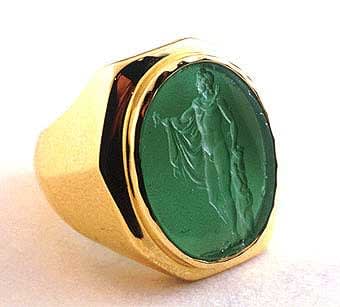Gold Ring Featuring an Aventurine Intaglio Depicting Hercules, 18th Century CE
Aventurine and Gold
FJ.6000
This genuine antique Classical Revival aventurine seal has been set in a modern 18 karat gold ring. The art of glyptic, or carving on colored precious stones, is probably one...
This genuine antique Classical Revival aventurine seal has been set in a modern 18 karat gold ring.
The art of glyptic, or carving on colored precious stones, is probably one of the oldest known to humanity. Intaglios, gems with an incised design, were made as early as the fourth and third millennia B.C. in Mesopotamia and the Aegean Islands. They display a virtuosity of execution that suggests an old and stable tradition rooted in the earliest centuries. The tools required for carving gems were simple: a wheel with a belt-drive, a set of drills, and abrasives, absolutely necessary since the minerals used were too hard for a metal edge to leave as much as a scratch on them. A special difficulty of engraving intaglios, aside from their miniature size, was that the master had to work with a mirror image in mind. This exquisite intaglio depicts the noble Hercules standing with his right arm extended draped with a flowing cape, while holding his famous club with his left hand. Set against a gorgeous green background, his body is a model of classical beauty, as perfectly formed as a statue by the great Greek sculptor Praxiteles. This intaglio is a true masterpiece of design that represents the perfect male physique in all its glory.
The art of glyptic, or carving on colored precious stones, is probably one of the oldest known to humanity. Intaglios, gems with an incised design, were made as early as the fourth and third millennia B.C. in Mesopotamia and the Aegean Islands. They display a virtuosity of execution that suggests an old and stable tradition rooted in the earliest centuries. The tools required for carving gems were simple: a wheel with a belt-drive, a set of drills, and abrasives, absolutely necessary since the minerals used were too hard for a metal edge to leave as much as a scratch on them. A special difficulty of engraving intaglios, aside from their miniature size, was that the master had to work with a mirror image in mind. This exquisite intaglio depicts the noble Hercules standing with his right arm extended draped with a flowing cape, while holding his famous club with his left hand. Set against a gorgeous green background, his body is a model of classical beauty, as perfectly formed as a statue by the great Greek sculptor Praxiteles. This intaglio is a true masterpiece of design that represents the perfect male physique in all its glory.



